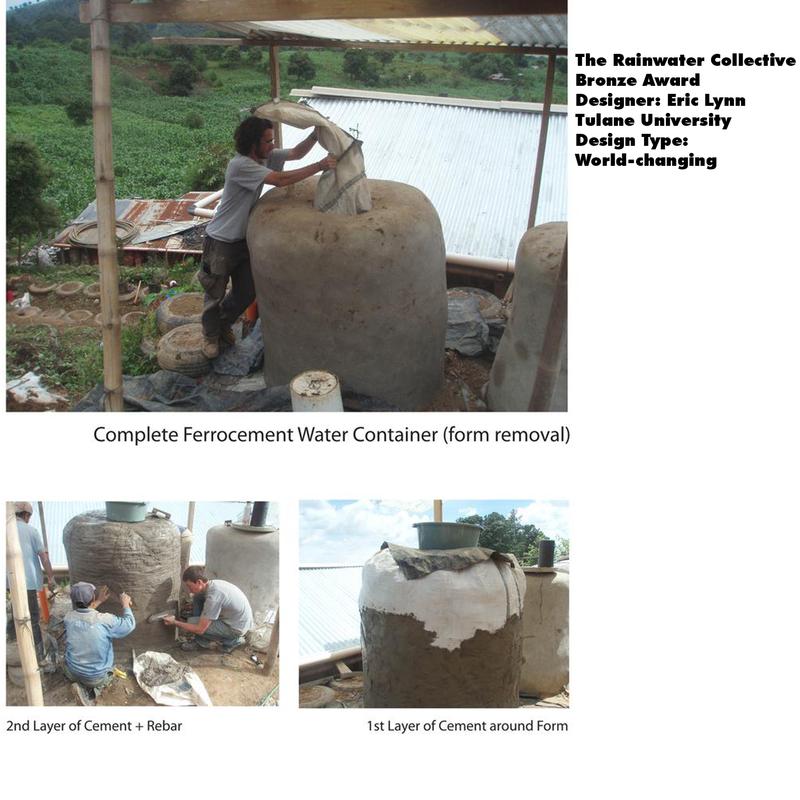2012 Galleries
The Spark Gallery pages are one of our most popular design destinations, with thousands of visitors each year. Check out some of the latest Spark entries, in the galleries below.
Galleries // 2012 Spark:Concept // Rainwater Collective
Rainwater Collective
Winner - Bronze
Competition: Spark:Concept
Designer: Mr. Eric Lynn
Design Type: Concept
The Guatemalan Highlands receive 60 inches of rainfall per rainy season. While many people in mountainous town of San Juan Comalapa have access to either community water centers or the municipal water line, they are not utilizing their abundant rainfall. Most of the town’s 40,000 residents live in a rural setting where water containment systems could be set up in a sustainable manner. Many of the roofs on small houses are corrugated steel and typically measure 20 x 8 feet. This 160-square-foot area sheds rainwater and presents an opportunity. During a 1-inch rainfall, 1 acre receives 27,154 gallons of water. This provides the crops and earth with enough water. But what about the people of Comalapa? During this same storm, their 160-square-foot roof could receive nearly 100 gallons of water. In the nearby city of Antigua, the rainy season can bring as much as 50 inches of rain per month during a 6-month span. However, most residents do not have the means to purchase a system to capture this water, so all of the rainwater is lost. The municipal system only runs for a few hours during on selective days, at which time people fill their pilas (water supply station) and jugs for usage. Occasionally, people further up the line use all of the water and people further down do not receive any water for that day. Also disease and death spread in Guatemala due to the untreated water that most people consume. The Rainwater Collective is system to collect household rainwater. It can do many things for individual homes as well as the surrounding community. The Rainwater Collective can exponentially benefit the health of people in the home by enabling them to drink clean and potentially purified water. If they’re healthy, children can attend school or assist in work. A filtration system and flush can work a part of the collection process or post-collection. The flush would create a secondary filter by letting sediment fall to the bottom of a tube while clean water flows through it. Also time would be saved because people would not have to travel for water. The average gallon of water weights 8.35 lbs., however, when people carry multiple gallons when transporting water from the source to their residence. This energy that is saved by the individual (usually female) could be spent on care for the fields, household or even a small business that may otherwise be neglected. The collection container can be 50-gallon water drums or ferrocement water tanks. While the drums can be bought, are made of strong plastics and are mobile, ferrocement offers the homeowner aspect sense of accomplishment. A ferrocement water tank would take a total of a week for completion; however, the building stage only lasts two days. One skilled worker and one unskilled worker could complete this task. The ferrocement technique essentially creates strong layers of thin concrete around a form; once the form is removed, a shell remains, which become the containment unit. While the task of creating ferrocement containers may seem mundane and less efficient, the benefits over a water drum include community involvement, durability, size, and low maintenance. Also new construction methods and environmental concerns would be taught to the families where these systems were implemented and create a sense of ownership for the individual. This is a very loose plan due to its versatility for various places of implementation. Many of these ideas are established by NGOs, the Peace Corp and other entities, but there is not an established system/plan that can be mass-distributed and produced. Simply, this can be made with 1 piece of PVC, 1 elbow, and a plastic drum for collection. While this would work in many environments, the human element is essential to successful development. By getting natives involved and having a simple filtration system, their lifestyles can improve exponentially. After successful implementation of the project, the job would be handed off slowly to local craftspeople for potential social entrepreneurship ventures. By creating an opportunity for social and economic innovation in this community, this project addresses the well-being of residents by simply adding in a system to utilize the world around them. The residents of San Juan Comalapa will become more self-sufficient with this sustainable addition to their lives, which could, in time, raise the community’s living standards as a whole.

